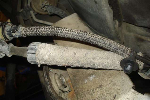mcglsr2
Member
- Joined
- December 21, 2019
- Messages
- 10
- Reaction score
- 12
- City, State
- Orlando, FL
- Year, Model & Trim Level
- 2020 Explorer ST
Hey everyone! I have a 2020 Explorer ST. Love it. I have the Tech package option which, among other things, adds two extra speakers to the B&O sound system. Overall, I find the B&O system to be quite good for an OEM system. However, as it always seems to be the case for me, the lows are never quite strong enough.
Backstory
I know there's an 8" sub in the back (it's a paper cone, if you happen to be wondering), but it doesn't really hit low enough for what I am used to. I decided to add on some extra grunt. My experience has been mostly with older vehicles that have a discrete radio (which I would replace, thus giving me pre-amp outputs). The only exception being my wife's DD, a '12 Audi A4 - but we had an audio shop install that sub and amp. Anyway, I decided to do this install my self.
Strategy
I did some research, bought a FSM, talked to the great folks at Crutchfield, and ultimately decided that the best place to grab the high level speaker input signal was from the wires feeding the OEM 8" sub. As it turns out, this sub has a dual voice coil, so the "Subwoofer 1" set of wires became my left channel, and the "Subwoofer 2" set of wires my right channel.
I would tap into those wires and run the signal to the amp nestled under the passenger seat. The power for the amp would come from the battery under/behind the passenger cowl, and the ground would come from a chassis connection near the amp.
The Equipment
It doesn't really matter for this "How To", but I selected a JL Audio 10" shallow sub (300W RMS @ 2 Ohm) in just about the smallest sealed box I could find. We use the Explorer as our family hauler so the cargo space in the rear is very precious to me. I don't want a massive sub box taking up all the space. So I found the smallest 10" box I could that would still sound great. For those wondering: it sounds great. For the amp, I selected a Rockford Fosgate T500X1br mono amp, it puts out 500W RMS @ 1 Ohm / 300W RMS @ 2 Ohm. The main reason I selected this amp (other than I love RF stuff) is its tiny size. It is really, really small. And the space under the passenger seat has an air duct taking up most of middle of that area, so I needed something small enough to fit along the side of the duct (which this does). The power and ground is a 8 gauge RF cable set with sting speaker wires blah blah blah. Enough words. Pictures. Here they are installed:


Backstory
I know there's an 8" sub in the back (it's a paper cone, if you happen to be wondering), but it doesn't really hit low enough for what I am used to. I decided to add on some extra grunt. My experience has been mostly with older vehicles that have a discrete radio (which I would replace, thus giving me pre-amp outputs). The only exception being my wife's DD, a '12 Audi A4 - but we had an audio shop install that sub and amp. Anyway, I decided to do this install my self.
Strategy
I did some research, bought a FSM, talked to the great folks at Crutchfield, and ultimately decided that the best place to grab the high level speaker input signal was from the wires feeding the OEM 8" sub. As it turns out, this sub has a dual voice coil, so the "Subwoofer 1" set of wires became my left channel, and the "Subwoofer 2" set of wires my right channel.
I would tap into those wires and run the signal to the amp nestled under the passenger seat. The power for the amp would come from the battery under/behind the passenger cowl, and the ground would come from a chassis connection near the amp.
The Equipment
It doesn't really matter for this "How To", but I selected a JL Audio 10" shallow sub (300W RMS @ 2 Ohm) in just about the smallest sealed box I could find. We use the Explorer as our family hauler so the cargo space in the rear is very precious to me. I don't want a massive sub box taking up all the space. So I found the smallest 10" box I could that would still sound great. For those wondering: it sounds great. For the amp, I selected a Rockford Fosgate T500X1br mono amp, it puts out 500W RMS @ 1 Ohm / 300W RMS @ 2 Ohm. The main reason I selected this amp (other than I love RF stuff) is its tiny size. It is really, really small. And the space under the passenger seat has an air duct taking up most of middle of that area, so I needed something small enough to fit along the side of the duct (which this does). The power and ground is a 8 gauge RF cable set with sting speaker wires blah blah blah. Enough words. Pictures. Here they are installed:











